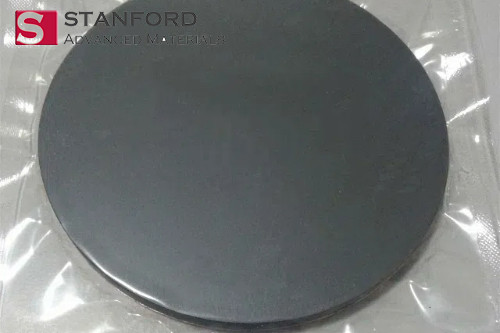Different Shapes of Sputtering Targets
(주)연진에스텍은 Planar (flat) Target과 Rotary (cylindrical) Target, Circular Target 및 Ring Target 등 대부분의 증착 공정에 부합하는 다양한 형태의 스퍼터링 타겟을 제공하며, 타겟 크기의 커스터마이즈가 가능합니다.
LiNi0.5Mn1.5O3 Product Overview
Stanford Advanced Materials (SAM) introduces the Lithium Nickel Manganese Oxide Target (LiNi₀.₅Mn₁.₅O₃), a specialized ceramic sputtering material designed for high-performance applications. This target is ideal for advanced battery technologies and thin-film energy storage solutions, thanks to its exceptional thermal stability and electrochemical properties.
Key Specifications
- Material Composition: LiNi₀.₅Mn₁.₅O₃
- Purity Level: 99.9%
- Form Factor: Planar Disc
Note: The specifications provided are based on theoretical data. For customized requirements and detailed inquiries, please contact us.
Detailed Product Description
The Lithium Nickel Manganese Oxide Target (LiNi₀.₅Mn₁.₅O₃) features a sophisticated layered oxide structure that leverages the beneficial properties of both nickel and manganese. This material is characterized by high thermal stability, robust structural integrity, and excellent electrochemical performance, primarily due to the synergistic interaction between nickel and manganese within its lattice. Nickel contributes to a high specific capacity, while manganese enhances safety and thermal stability.
LiNi₀.₅Mn₁.5O₃ typically crystallizes in a monoclinic or layered structure, ensuring stable lithium-ion diffusion pathways essential for uniform sputtering and thin-film deposition. The material boasts good electrical conductivity and chemical homogeneity, making it a dependable choice for high-performance lithium-ion battery cathodes and thin-film energy storage applications. Additionally, the target exhibits excellent adhesion to substrates and maintains consistent compositional uniformity throughout the deposition process.
LiNi0.5Mn1.5O3 Applications
- Thin-Film Lithium-Ion Battery Cathodes: Utilized for depositing high-performance cathode materials that offer balanced capacity, thermal stability, and safety for next-generation rechargeable batteries.
- Microbatteries and Solid-State Batteries: Ideal for fabricating micro-scale power sources used in compact and flexible electronic devices.
- Electrochemical and Energy Research: Commonly employed in research and development for creating novel energy materials and testing advanced cathode chemistries.
- Sputtering and Pulsed Laser Deposition (PLD): Used in the production of uniform thin films with controlled stoichiometry in both academic and industrial laboratories.
LiNi0.5Mn1.5O3 Packaging Details
Our Lithium Nickel Manganese Oxide Targets are meticulously packaged to ensure their protection during shipping and storage. Depending on the size, smaller targets are securely packed in polypropylene (PP) boxes, while larger targets are shipped in custom-built wooden crates. We prioritize customized packaging solutions and utilize appropriate cushioning materials to provide optimal protection throughout transit.
Packaging Options:
- Carton
- Wooden Crate
- Customized Packaging
Manufacturing Process
Manufacturing Workflow

Testing Methods
- Chemical Composition Verification: Utilize techniques such as Glow Discharge Mass Spectrometry (GDMS) or X-ray Fluorescence (XRF) to ensure the material meets purity and composition standards.
- Mechanical Properties Assessment: Perform tests for tensile strength, yield strength, and elongation to evaluate material performance.
- Dimensional Measurements: Measure thickness, width, and length to ensure compliance with specified tolerances.
- Surface Quality Inspection: Detect defects such as scratches, cracks, or inclusions through visual and ultrasonic examinations.
- Hardness Evaluation: Assess material hardness to ensure uniformity and mechanical reliability.
Frequently Asked Questions
Q1: What deposition techniques are compatible with this target?
A1: This target is compatible with sputtering methods (especially RF and pulsed DC) and pulsed laser deposition (PLD), depending on your equipment and application needs.
Q2: Can this target be customized in size or shape?
A2: Yes, SAM offers customization of the target’s size, thickness, and backing plate options to meet your specific system requirements.
Q3: How should the target be stored?
A3: Store the target in a clean, dry environment, away from moisture and direct sunlight. Sealed packaging is recommended to preserve its quality until use.
Performance Comparison: LiNi₀.₅Mn₁.5O₃ vs. Competing Materials
| Property | LiNi₀.₅Mn₁.5O₃ (Standard) | LNMO (Cu/Al/Ti Doped) | LNMO (Ag-Coated) | LiCoO₂ | LiFePO₄ |
| Working Voltage (V vs. Li/Li⁺) | 4.7 | 4.7 | 4.7 | 3.8 | 3.4 |
| Specific Capacity (mAh/g) | 130-140 | 137 (initial) | 135.2 (1C) | 140-160 | 150-170 |
| Cycle Stability (Capacity Retention) | ~10.8% @500 cycles (without additives) | 97.9% @120 cycles (0.1C) | 98.4% @240 cycles (1C) | ~80% @500 cycles | >95% @500 cycles |
| Li⁺ Diffusion Coefficient (cm²/s) | ~2.97×10⁻¹⁵ (undoped) | 2.04×10⁻¹³ (improved) | N/A | ~1×10⁻¹¹ | ~1×10⁻¹⁴ |
| Crystal Structure | Spinel | Spinel | Spinel | Layered | Olivine |
| Grain Size | N/A | N/A | N/A | N/A | N/A |
| Cost | Medium | Medium-High | High | Very High | Low |
Raw Materials Information
Lithium (Li)
Lithium is a soft, silvery-white alkali metal known for its high electrochemical potential, making it a crucial component in rechargeable batteries, including lithium-ion and solid-state variants. It is also utilized in advanced ceramics, glass production, and lightweight metal alloys.
Nickel (Ni)
Nickel is a lustrous, silvery-white metal recognized for its excellent corrosion resistance, ductility, and strength. It is widely used in alloys, particularly in stainless steel and superalloys, as well as in electroplating, battery production, and magnetic materials.
Manganese (Mn)
Manganese is a hard, brittle gray-white metal commonly used to enhance the strength, toughness, and wear resistance of steel and other alloys. It plays a vital role in lithium-ion battery cathode materials due to its favorable redox properties and cost-effectiveness.
- High Purity & Performance 일관된 증착 품질과 오염을 줄이도록 가공합니다.
- Material Variety 다양한 응용 분야의 요구 사항에 맞게 순수 금속, 합금, 세라믹 및 화합물로 제공됩니다.
- Custom Manufacturing 특정 시스템의 필요요구 사항에 맞게 크기와 형태, 조성을 맞춤화했습니다.
- Precision Design 반복 가능하고 균일한 박막 결과를 위해 엄격한 공차로 제조되었습니다.
- Flexible Supply Chain 최고의 제조업체와 강력한 파트너십을 통해 일관된 품질과 on-time 납품을 보장합니다.
하기

